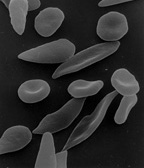Fetal hemoglobin
(Redirected from Hemoglobin F)
Fetal hemoglobin (HbF) is a type of hemoglobin that is present in the fetus and newborn. It is composed of two alpha and two gamma chains (α2γ2), which distinguishes it from adult hemoglobin (HbA), which consists of two alpha and two beta chains (α2β2). HbF has a higher affinity for oxygen than adult hemoglobin, which facilitates the transfer of oxygen from the maternal to the fetal circulation.
Structure and Function[edit | edit source]
Fetal hemoglobin is structurally different from adult hemoglobin due to the presence of gamma chains instead of beta chains. This difference in structure allows HbF to bind oxygen more tightly than adult hemoglobin. The higher oxygen affinity of HbF is crucial for fetal development, as it allows efficient uptake of oxygen from the placenta, where the partial pressure of oxygen is lower than in the lungs.
The oxygen dissociation curve of HbF is shifted to the left compared to that of adult hemoglobin, indicating its higher affinity for oxygen. This property is essential for the fetus to extract oxygen from the maternal blood supply.
Genetic Regulation[edit | edit source]
The production of fetal hemoglobin is controlled by genes located on chromosome 11. The gamma globin genes (HBG1 and HBG2) are active during fetal development but are usually silenced after birth as the beta globin genes (HBB) become more active.
In some individuals, the production of fetal hemoglobin persists into adulthood, a condition known as hereditary persistence of fetal hemoglobin (HPFH). This can be beneficial in certain hemoglobinopathies, such as sickle cell disease and beta-thalassemia, where increased levels of HbF can ameliorate symptoms.
Clinical Significance[edit | edit source]
Fetal hemoglobin plays a significant role in certain blood disorders. In sickle cell disease, the presence of HbF can reduce the sickling of red blood cells and alleviate symptoms. Similarly, in beta-thalassemia, increased levels of HbF can compensate for the lack of functional beta chains.
Therapeutic strategies to induce the production of fetal hemoglobin in adults are being explored as potential treatments for these disorders. Drugs such as hydroxyurea have been used to increase HbF levels in patients with sickle cell disease.
Also see[edit | edit source]
Search WikiMD
Ad.Tired of being Overweight? Try W8MD's physician weight loss program.
Semaglutide (Ozempic / Wegovy and Tirzepatide (Mounjaro / Zepbound) available.
Advertise on WikiMD
|
WikiMD's Wellness Encyclopedia |
| Let Food Be Thy Medicine Medicine Thy Food - Hippocrates |
Translate this page: - East Asian
中文,
日本,
한국어,
South Asian
हिन्दी,
தமிழ்,
తెలుగు,
Urdu,
ಕನ್ನಡ,
Southeast Asian
Indonesian,
Vietnamese,
Thai,
မြန်မာဘာသာ,
বাংলা
European
español,
Deutsch,
français,
Greek,
português do Brasil,
polski,
română,
русский,
Nederlands,
norsk,
svenska,
suomi,
Italian
Middle Eastern & African
عربى,
Turkish,
Persian,
Hebrew,
Afrikaans,
isiZulu,
Kiswahili,
Other
Bulgarian,
Hungarian,
Czech,
Swedish,
മലയാളം,
मराठी,
ਪੰਜਾਬੀ,
ગુજરાતી,
Portuguese,
Ukrainian
Medical Disclaimer: WikiMD is not a substitute for professional medical advice. The information on WikiMD is provided as an information resource only, may be incorrect, outdated or misleading, and is not to be used or relied on for any diagnostic or treatment purposes. Please consult your health care provider before making any healthcare decisions or for guidance about a specific medical condition. WikiMD expressly disclaims responsibility, and shall have no liability, for any damages, loss, injury, or liability whatsoever suffered as a result of your reliance on the information contained in this site. By visiting this site you agree to the foregoing terms and conditions, which may from time to time be changed or supplemented by WikiMD. If you do not agree to the foregoing terms and conditions, you should not enter or use this site. See full disclaimer.
Credits:Most images are courtesy of Wikimedia commons, and templates, categories Wikipedia, licensed under CC BY SA or similar.
Contributors: Kondreddy Naveen, Prab R. Tumpati, MD



